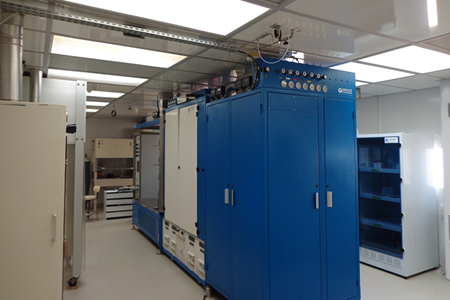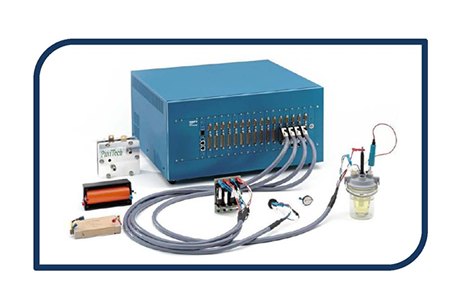Technological Platforms - CRTSE -

Platform Photovoltaic

Thins Films & Interfaces

Raw Materials

Effluents Treatment
Platform Photovoltaic
The missions of DDCS Division focuses on the study, design, implementation and development of technological processes in order to give rise to prototypes of photovoltaic solar cells with silicon and with other semiconductor materials such asGaAs, CIGS, TCO’s.
The main objective is to test all technology segments having to lead in a first step to the realization of mono and multicrystalline silicon dased solar cells (from wafers developed at CRTSE) whose conversion officiency would exceed 15% one distinguishes three types of R&D action for this division:
- Development of basic technological segments on multicrystalline silicon, which is currently the dominant technology (chemical surface treatment, passivation, diffusion doping, metallization by screen printing, ect..) in order to realize solar cell with international performance (conversion efficiencies >15%);
- Research on alternative processes and emerging devises that could likely compete in medium term with silicon material. (2nd and 3rd generation devices);
- Control of associated technologies to the developed processes and work out reverse engineering for expensive consumables.
The processing activity is supported by the development of sharp characterization technique:
- To control step by step of the stages of material elaboration and device realization;
- Process validation according to international standars of elaborated prototypes performance for their transfer forwards the industrial sector.
Raw Materials
Upstream and to complete already existing technological segments at CRTSE,
the raw material treatment and crystal growth Division (CCPM) objectives are :
- Enrichment of silica for electro metallurgy;
- Carbon-reduction of silica to get metallurgical grade silicon (Si-MG);
- Purification of Si-MG to get solar grade silicon(Si-SoG);
- Use of crystal growth method to get monocrystalline materials with specific properties;
- Implementation of physic-chemical characterization techniques for the control and the validity of elaborated material;
- Undertake research and development on crucibles and other consumables specific to silicon growth;
- Numerical simulation of the crystal growth process by vertical Bridgman method;
- Treatment of chemical wastes resulting from photovoltaic processes.

Thins Films and
Interfaces
The mission of CMSI Division is to promote a multi-field R&D associating the fundamental and applied aspects in the field of advanced materials (organic, inorganic and hybrid), of surfaces and interfaces, nanosciences (nanostructures and nanotechnologies) and biotechnologies.
From earlier research tasks which she has been undertook with perseverance for several years CMSI Division capitalizes an invaluable know-know based on pioneer experiments in Algeria in the field of materials, thin layers deposition by several methods, surface structuring, semiconductors functionalization and the devices in general. The Division is composed of specialized researchers trained within the Centre, and rely on material resources that enable it to carry out a rich program on varied themes, finding various applications in the field of energy (storage of energy, photovoltaic cell…), telecommunications (information storage, optoelectronics).
CMSI division focuses on two main areas:
- Development of materials and processes in thin surface layers and interfaces;
- Structures and devices for detection, optoelectronics and conversion.
TRAITEMENT DES EFFLUENTS LIQUIDES

Le Centre de Recherche en Technologie des Semi-conducteurs pour l’Energétique (CRTSE) a pour mission le développement et la promotion de la technologie des dispositifs à semi-conducteurs pour la conversion énergétique. La protection de l’environnement est intégralement prise en charge in-situ par notre personnel dans un atelier de traitement des effluents (ATE) dédié à la gestion, le traitement et la valorisation des effluents liquides conformément aux normes algériennes de rejets (décret exécutif n° 09-209 du 17 Joumada Ethania 1430 correspondants au 11 juin 2009).
Notre atelier jouit d’une expérience et d’avoir savoir, et savoir-faire non-négligeable dans le traitement des rejets issus des différents process technologiques, en particulier les rejets acides du Centre de Recherche en Technologie Avancée (CDTA), le traitement des acides périmés de la société Allemande M+W Facility Engineering GmbH, ainsi que les rejets de Socothyd. Ces structures ont fait confiance à nos compétences et notre savoir-faire.
Avec le CRTSE, vous bénéficiez de l’apport d’une équipe expérimentée aux compétences variées et complémentaires. Les solutions que nous proposons à nos clients sont adéquates, efficaces et complètes. En effet, notre action est multiple et englobe toutes les étapes de la prestation, notamment la logistique et le stockage.
Vous trouverez ci-joint notre offre de service, espérant qui va correspondre à vos attentes, je vous prie d’agréer, Monsieur, mes salutations distinguées.
Le CRTSE dispose d’un atelier de traitement des effluents qui a pour mission la gestion, traitement et valorisation des effluents liquides issus des différents processus technologiques :
☛ La microélectronique ;
☛ L’industrie de traitement & revêtement de surfaces ;
☛ La Photovoltaïque ;
☛ Les abattoirs ;
☛ Les textiles ;
☛ La chimie ;
☛ L’industrie du verre & cristallerie.
L’Atelier développe un choix de service pour résoudre certaines problématiques environnementales :
- Tri sélectif des effluents liquides ;
- Mise à disposition des personnels qualifiés pour le traitement des effluents ;
- Transport et stockage des déchets dangereux avant traitement ;
- Un laboratoire de caractérisation pour l’analyse physico-chimique avant et après traitement ;
- Mise à disposition d’un équipement spécifique pour le traitement des effluents liquides acido-basiques ;
- Mise à disposition d’un équipement spécifique pour le recyclage des solvants organiques (chlorés et oxygénés) ;
- Traitement des produits chimiques périmés ;
- Mise à disposition d’un chauffage solaire des boues produites par physico-chimique ;
- Stockage, valorisation ou incinération des boues dans un centre spécialisé.
CAPACITY STENGTHENING FRAMEWORK
CNRST - 46 Boulevard Mohamed V, Alger
DGRSDT - 24 Mohamed Guassem, Alger
LRI-Annaba, Université Badji Mokhtar

![Science Technology and Innovation [STI-Portal]](https://ibtikar.info/wp-content/uploads/2019/08/STI-KT2.png)